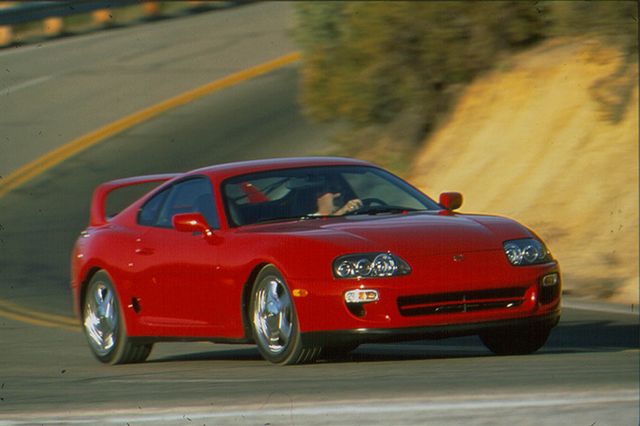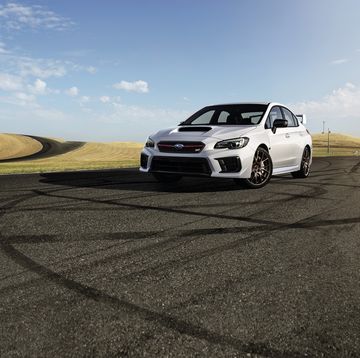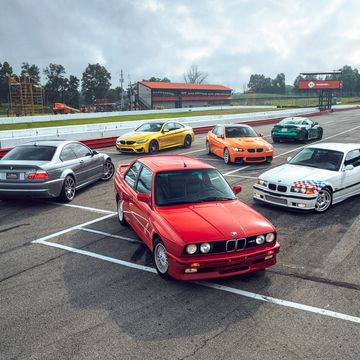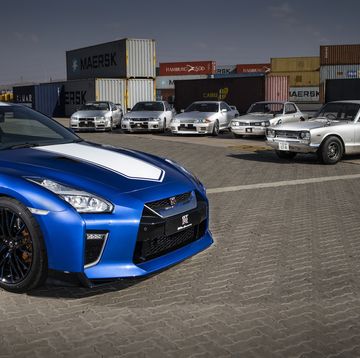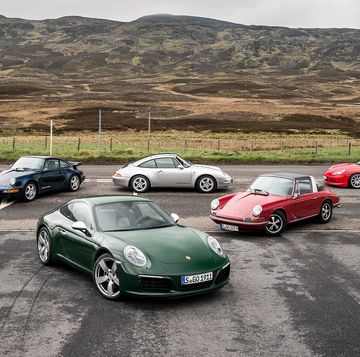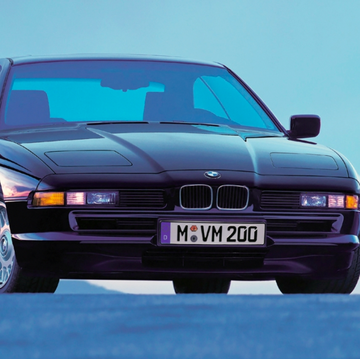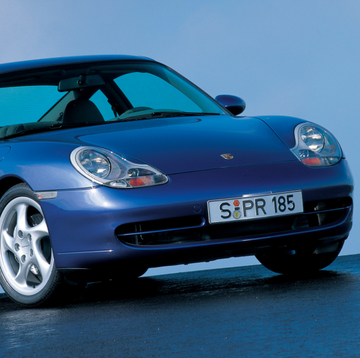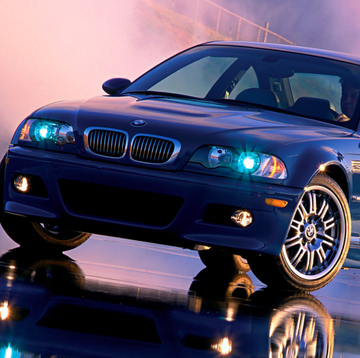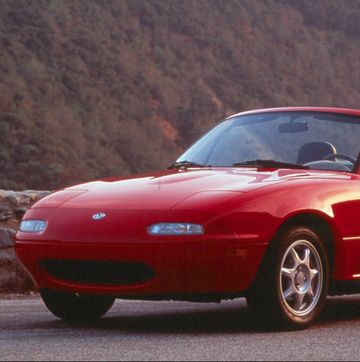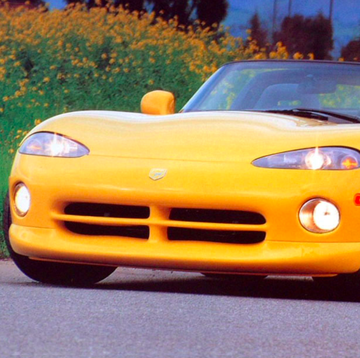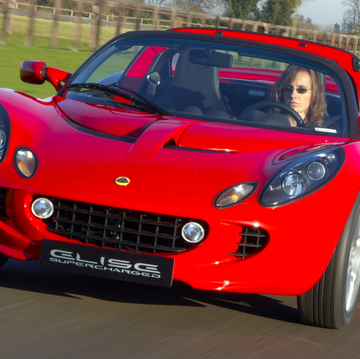Overview
The Toyota Supra has always been a car of its time. Over the decades it has variously taken the form of a long-nosed personal luxury coupe, a juggernaut grand tourer, and a shared-platform sports car. The Supra badge always adorns the pinnacle of Toyota coupes, but it can mean different things.
Still, over five generations, the Supra has offered plenty for enthusiasts to be excited about. And to argue over, especially with the current generation's BMW roots.
It would be all too easy to anoint the powerful fourth-generation Supra as the best of breed and tell Vin Diesel to break out a celebratory bucket of Coronas, but there's an argument to be made for every generation. Here's a look over how each generation of this car defined the meaning of the word Supra.
First Gen Mk1 (A40/A50)
Introduced into the U.S. market in 1979, the first generation of Supra is as slightly embarrassing as the polyester clothes of the period. Toyota had not built a proper six-cylinder sports car since the 2000GT, which was hardly affordable to the everyman. Toyota executives must have been fuming, having left the door open for the Datsun 240Z to lead the segment.
However, by the late Seventies, the once-sprightly 240Z had morphed into the much softer 280ZX. Think crushed velour suit, not tracksuit. Toyota responded by lengthening the nose of its Celica liftback to accommodate the 2.6-liter single-overhead-cam inline-six out of the Cressida sedan.
Fitted with Bosch fuel injection, the six made a ho-hum 110 hp. It was, however, as smooth as a Barry White vocal track, and provided decent highway cruising performance. Further, the Supra was fitted with more equipment than the Celica, everything from rear disc brakes to an available eight-track player. Our review at the time summed things up: “the basic layout is Celica, but with schmaltz.”
From a dynamic standpoint, the review descends into something of a bloodbath. “One of the most insecure-feeling beasts I've driven on a twisty road.” “It feels like Toyota has removed all road feel in deference to the car's luxury image.” “Most modern automobiles understeer, but the Supra does it with a vengeance.” “It's nothing but a boulevard GT.”
Overall, the Celica Supra was a first, obviously unconvincing effort. Happily, Toyota kept at it.
• The Supra is 5.1 inches longer than the Celica. Lots of Celica replacement parts should work, just not up front.
• Being somewhat unloved makes it rarer. Few owners kept their cars up, making this generation one of the rarest Supras to see on the road.
• The optional Sport Package in later models added raised-white-letter tires, mudflaps, and spoilers. At least it looks fast.
Of Note:
- 1978 – In order to work around Japanese displacement taxes, the home-market Supra came with a 2.0-liter engine. Whereas the JDM versions of other Japanese cars often got more powerful variants than those sold overseas, the Supra was often more potent in the U.S. market, with a few exceptions.
- 1979 – The Supra may have had no business being on a race track, but it did appear on one once, when it was the pace car for the 1979 U.S. Grand Prix. Basically, you might win a prize at Radwood with a Sport Package 1981 model, but you won't win anything else.
Second Gen Mk2 (A60)
Benefiting from a redesign of the Celica, the Supra found itself lifted from the worst automotive trends of the Seventies and propelled into the squared-off futurism of the Eighties. With its chunky flares, pop-up headlights, and integrated hatch spoiler, the MkII Supra is pure Duran Duran.
Not only has this generation of Supra aged well in terms of design, but it also came with solid performance chops. Models equipped with the five-speed manual transmission initially produced 145 hp from their twin-cam, 2.8L straight-six, later bumped to 160hp for the 1984 model year.
The Supra won critical acclaim, with Car and Driver's David E. Davis declaring, “The new Supra is a nearly perfect car. The Porsche people must look at the Supra, then look at their own 924, and wonder if they're in the right business.” Apart from some complaints about the complexity of the stereo, with its seven equalizer sliders, Toyota had a hit on its hands.
• Rust is more of a concern than mechanical issues. Watch around the hatch and rear shock towers.
• The 5M-GE inline-six is known to be robust, as is the five-speed manual. Oil pressure regulators are one weak point on early models, but parts availability isn't bad.
• Trim parts are hard to come by. Interior and exterior bits aren't available from Toyota these days, so you'll have to scour junkyards and eBay.
• 1984 and later models are the most desirable. The power bump wasn't huge, but it's worth tracking one down.
Of Note:
- 1983 – MkII Supras began racing as a Division Three touring car, competing against the likes of BMW's 635CSi. They were considered a little underpowered, but did eke out a few wins.
- 1985 – Turbocharged racing rivals largely outperformed the Supra, but crowds came to see driver Barry Sheene, a world champion motorcycle racer.
- 1985 – Because of delays with the third-generation Supra, production of the MkII was held over for a year. 1986 model-year Supras are all the most desirable Performance types.
Third Gen Mk3 (A70)
Arriving near the peak of Japan's golden age of automobile manufacturing, the third-generation Supra offered a huge amount of technology and performance. It would be arguably more impressive if it wasn't slightly overshadowed by the MkIV that followed it.
First available in naturally-aspirated form as a 1986.5 model, the Supra really improved when turbocharging showed up the following year. The boosted 3.0-liter straight-six now made 232 hp and 252 lb-ft of torque, and offered a claimed 0-60 mph time of 6.1 seconds.
A relatively heavy car because of all the technology it carries, a MkIII Supra is nonetheless capable of being tuned to be fairly quick. Double wishbones at all four corners and an optional limited-slip differential help make back roads fun, and even if the naturally aspirated versions aren't particularly fast, they're still charming.
• Check your head (gaskets). Probably the biggest Achilles' heel on the third-gen Supra is a tendency for blown head gaskets. The initial factory torque settings were too low, so ensure that they're torqued to spec.
• Rust can be an issue in wet climates. As the Supra is a hatchback, leaks can be common in the rear. Check the low points in the trunk, including the spare tire well.
• Engine swaps are not uncommon. Done right, the Japanese-market 1JZ 2.5-liter turbocharged inline-six provides 280 hp in stock form, and can easily be modified for more.
• Turbocharged models got a stronger manual transmission. If you're going to be raising boost, ensure that you've got the tougher R154 gearbox, rather than the light-duty W58.
Of note:
- 1987 – The Supra has some genuine rally pedigree, being entered in the Safari Rally first in both naturally aspirated and turbocharged form. Being a little bulky for the task, rallying duties were soon returned to the Celica.
- 1987 – The Supra was also initially competitive in Japanese Group A racing, winning its class and often out qualifying rivals from Nissan. However, rule changes, and the car's weight soon saw it overshadowed by the likes of the Nissan Skyline GT-R.
- 1988 – Homologated for Group A racing, the Supra Turbo-A was a limited-run model available only in Japan. It came with a host of tweaks to its turbocharged 3.0L inline-six, good for about 276 hp.
- 1990 – Last of breed Supras in Japan came with twin-turbo 2.5-liter engines that were a harbinger of greatness to come. The best of these is the 2.5 Twin Turbo R model, which came with lighter swaybars, a bigger intercooler, interior upgrades from Recaro and Momo, and an improved suspension. It's as light and quick as a production MkIII Supra ever got.
Fourth Generation Mk4 (A80)
Towards the beginning of the Nineties, Japan's automakers were producing some of the most exciting cars ever made. The Acura NSX offered mid-engined dynamics and all-aluminum weight savings. The twin-turbo Mazda RX-7 was razor-edged and unforgiving. The Mitsubishi 3000GT was crammed with technology. And the MkIV Supra? That was Toyota's mic drop moment.
Introduced in 1993, the MkIV Supra Turbo came with a 320 hp twin-turbo straight-six, an available Getrag six-speed gearbox, and was roughly 200 lb lighter than the third-generation car. In testing, it pulled nearly 1g on the skidpad, ran through the slalom at 66 mph, and could sprint to 60 mph in five seconds or less.
At the heart of this beast was the 2JZ-GTE powerplant, which featured double overhead cams in an aluminum head and a cast-iron block. This time, Toyota's engineers didn't leave any weak points, overengineering the motor to the point that nearly doubling the output is merely a case of adding more fuel and boost.
The Supra was still more a grand tourer than an outright sports car, but all the performance you could want was there. However, the top of range Turbo models were also quite expensive, which made them rare when new, and consequently, pricey now. The “more than you can afford, pal” shoe is now on the other foot.
The naturally aspirated MkIV Supra isn't quite the juggernaut that a Turbo is, but they're still quite desirable. Power is a reliable 220 hp.
• U.S.-market models are more powerful. With bigger turbochargers and larger stock injectors, Supras sold outside of Japan have roughly forty more horsepower than the JDM versions. Of course, there's plenty of power left on the table for both.
• The Supra left the U.S. market early. The Supra was sold in Japan until 2002, but the last U.S. Supras were 1998 model-years. If you're Canadian, Supras were only sold there until 1996, and are very hard to find. Sorry.
• Almost everything is over-engineered but watch for warning signs. The six-speed Getrag transmission and rear differential on the Turbo models are particularly strong, so should be holding up well. There's often a clunk shifting from reverse into first, which is normal. Watch for whining under power.
• Modifications are common. Overboosted Supras are the rule, rather than the exception, and not every wrench has been turned by a professional. Watch out for corners being cut.
Of note:
- 1995 – In Japanese Grand Touring Racing specification, a Supra was fielded at the 24 Hours of Le Mans, finishing 14th. Weirdly, it wasn't equipped with its original inline-six but with a 2.1-liter four-cylinder engine boosted to 650 hp.
- 1996 – In the US, all Turbo models came with an automatic transmission as standard, as well as a Targa roof. The manual transmission returned the next year.
- 1997 – When tested by Car and Driver, a Supra Turbo managed a 70-0 mph stopping distance of 149 ft. This remained the shortest stopping distance recorded by the magazine for seven years, until a Porsche Carrera GT bested it in 2004 by just 4 ft.
- 1998 – In the last year of U.S. sales, the Supra Turbo wasn't available in states with CARB emissions standards.
- 2001 – The original The Fast and the Furious Supra was actually the real deal. Belonging to the film's technical director, Craig Lieberman, it had a single T-66 turbo upgrade, 650cc injectors, and made roughly 550hp.
- 2007 – Probably the wildest street Supra of all time is the golden Top Secret Supra created by Kazuhiko “Smoky” Nagata. Improbably, it has the V-12 engine out of the Toyota Century limousine installed, as well as a pair of turbos, for an output of more than 1000 hp.
Fifth Generation Mk5 (A90)
The fifth-generation Supra arrived with a completely different mission to its predecessors. While previous Supras had blended performance and luxury, this new car, co-developed with BMW, would be primarily a sports car.
The move didn't please every Supra fan, nor did the lack of a manual transmission. Still, turbocharged straight-six performance—courtesy of BMW's B58 3.0-liter—was still on the table, and the new Supra was lighter on its feet than its ancestors. It also produced acceleration numbers a second quicker to 60 mph and through the quarter-mile than the mighty MkIV Turbo.
But numbers aren't everything. At Road & Track's 2020 Performance Car of The Year shootout, the Supra was among the first cars cut.
“The Toyota somehow manages to be joyless,” editor-at-large Sam Smith said, after his first session. “There’s no reward for focus, no incentive to be a hooligan… It doesn’t feel like any fast Toyota I’ve driven. None of the confidence or unflappability of a second- or third-generation Supra.”
With a new turbocharged 2.0-liter four-cylinder for 2021 and more power for the inline-six, the Supra is still something of a conundrum. Our editors agree that the four-cylinder handles a little more sweetly, but both versions of the Supra continue to split opinions.
Having said that, there's no denying how quick the current car is, and Toyota isn't quite finished with it yet. A low-spec track-focused version of the 3.0-liter car is rumored to be in the offering.
As for the big question—reliability—the new Supra doesn't just share parts with the Z4, it's built in the same Austrian factory. Expect maintenance and parts pricing to reflect the BMW roundels found under the hood, rather than the Toyota badge on the nose.
• The six-cylinder 2021 model makes more power, but essentially the same torque. Horsepower jumped from 335 hp in the 2020 version to 382. Torque came up a who-cares 3 lb-ft.
• You can't lower the windows, but there's a fix. At speed, dropping the Supra's windows results in considerable buffeting. Happily, the aftermarket has stepped in with a couple of options in the form of small, stick-on deflectors that can be attached near the base of the side mirrors.
Of Note:
- The Supra GT4 is the racing version, intended to take the fight directly to Porsche and other GT4-class cars. Power is up to 430 hp, curb weight is below 3000 lbs, and the price is a projected $194,000.
Collectability:
A manual transmission MkIV Supra Turbo is the one every Supra fan dreams of owning, whether they enjoyed the original Fast and the Furious movie or not. Unfortunately, many Supras did not survive the tuning boom that followed the popularity of Dom and Brian.
A commonly quoted figure for U.S. MkIV Supra sales is slightly above 11,000, with a little over a third of those fitted with a six-speed manual and twin-turbocharging. Stock, low-mileage examples have been fetching eye-watering prices at auction, as collector market interest in Japanese vehicles increases.
Prices are high and level—there are few deals to be had. Japanese-market models from 1995 and earlier are much less expensive and more plentiful. Another option is to take a modified Supra and return it to a more stock form, protecting your investment.
The Ones to Get
- As they're all the most-appealing Performance models, searching for the 1986 model year will net you the MkII you're looking for. Subject to condition, of course.
- Today, a homologation-special Supra Turbo-A will fetch near-MkIV Turbo pricing, as Toyota only built 500 of them. Consider it the Buick GNX of the Supra world: all-black, and highly collectible. Never sold in the U.S., they're currently importable from Japan.
- Also an excellent grey-market import option is a MkIII Supra Twin Turbo R. As fast as the third-generation Supra ever got, these have desirable upgrades throughout and comes with the robust 1JZ twin-turbo engine. Prices remain quite reasonable.
- Any good condition, six-speed-manual, U.S.-market MkIV Supra Turbo is going to fetch strong money. Differences among the years are granular, and up for debate, but a 1993-1995 hardtop with the Torsen LSD is probably the enthusiast's pick.
Notable Issues / Problems
- Rusting can be an issue for second-generation Supras, even in drier climates.
- Headgasket issues have likely already been addressed in surviving MkIII Supra Turbos, but check carefully to make sure lasting damage hasn't occurred.
- The MkIV Turbo is overall very robust but can present minor annoyance like leaking valve seals and leaky Targa tops as they age.
Specs
Critical Reception
"The Supra is an enigma. Its European-like styling is pleasing to the eye. It's smooth, quiet, luxurious and well equipped. And the quality of construction and materials says Toyota through and through. But with a base price of $9578, the Supra is anything but a bargain. It's about $1500 more expensive than the RX-7 GS and costs about $1800 less than a comparably equipped 280ZX, cars with truly sporty handling and performance. Yet the Supra has little of the sporting character found in these other two sports/GTs."
-Road & Track, August 1979
"It has become increasingly apparent that the Japanese automakers have caught and in many cases surpassed the best of the U.S. and European manufacturers in whatused to be considered the sacrosanct area of sports/GT cars. With the 1982 Supra, Toyota has muscled right into the front line of GT cars."
-Road & Track, February 1982
"The 1989 Supra Turbo is the perfect car for the moderately heeled enthusiast buyer who wants to try everything on the menu: performance, comfort, roominess, stylishness, durability and reliability."
-Road & Track, Feburary 1989
"But then why get on and off the throttle when you can keep it pressed down and thunder to 60 mph in 5.0 seconds? Nice round number, five seconds. And bettered in our Road Test Summary by only the Dodge Viper, Ferrari's 512TR and F40, the Lamborghini Diablo, Shelby's 427 Cobra and the Vector W8 TwinTurbo."
-Road & Track, March 1993
"[T]here’s not much Supra here—none of the name’s legendary solidity and brawn—or even much Toyota. The chassis and driveline are shared with the BMW Z4; the badge on the hood has a BMW part number. The interior smells like a BMW. And despite the Toyota-specific suspension and driveline tune, the car suffers from the same maladies that plague most modern BMWs."
-Road & Track, November/December 2019





